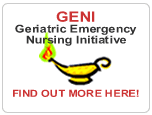Acute Care Geriatric Nurse Network
British Columbia's Clicical Nurse Specialists in Geriatrics, Gerontology, Geropsychiatry, Geriatric Rehabilitation, and Nurse Continence
"Providing nurses tools for 360° vision while proactively assessing older adults in BC"
Continence
Purpose
-
To maintain urinary continence in the acutely ill patient in hospital.
-
To promote the restoration of urinary continence.
-
To promote the attainment of a patient-centered achievable level of continence for the chronically incontinent patient.
Background
Seven percent of community dwelling adults in Canada experienced urinary
incontinence during the previous year. (Angus Reid Group 1997) Women
are twice as likely to experience UI than men (12% versus 2.5%).
Up to 35% of community-dwelling people over the age of 60 and 50%
of institutionalized residents experience UI. (AHCPR UI Guidelines 1996)
In addition to being inconvenient and embarrassing, urinary incontinence
(UI) can be the precursor to serious health problems. Some
of these problems include UTI, renal failure, depression, and falls.
The cost to manage UI is estimated to be about 2.6 billion per year in
Canada. (M. Shaw 1998)
A hospitalized patient whose mobility and functional status has been altered
due to their current acute illness is at a high risk for developing urinary
incontinence. If assessed and treated promptly, UI can be effectively
reversed or appropriately managed. (BC Medical Journal 1996)
Downloads
![]() Appendix
B - Care Assessment and Treatment Plan
Appendix
B - Care Assessment and Treatment Plan
![]() Appendix C
- Pelvic Muscle Exercises for Women and Health Promotion Checklist
Appendix C
- Pelvic Muscle Exercises for Women and Health Promotion Checklist
![]() Appendix D
- Pelvic Muscle Exercises for Men and Health Promotion Checklist
Appendix D
- Pelvic Muscle Exercises for Men and Health Promotion Checklist
